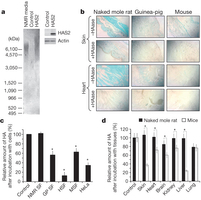Nature:高分子量透明质酸保护裸鼹鼠从不患癌症
| 导读 |
发表在Nature杂志上的文章称,罗切斯特大学科学家发现了保护裸鼹鼠从不患癌症的化学物质。该发现为治疗癌症提供了新的思路。
裸鼹鼠是一种小型,无毛,生活在地下的一种啮齿类动物,该鼠寿命为30年,并且在其一生中从未换癌症。由Seluanov博士和Gorbunova博士带领的研究团队发现保护该裸鼹鼠免患癌症的原因,由于其组织中富含高分子量的透明质... |

发表在Nature杂志上的文章称,罗切斯特大学科学家发现了保护裸鼹鼠从不患癌症的化学物质。该发现为治疗癌症提供了新的思路。
裸鼹鼠是一种小型,无毛,生活在地下的一种啮齿类动物,该鼠寿命为30年,并且在其一生中从未换癌症。由Seluanov博士和Gorbunova博士带领的研究团队发现保护该裸鼹鼠免患癌症的原因,由于其组织中富含高分子量的透明质酸(high molecular weight hyaluronan ,HMW-HA)。
研究人员注意到培养裸鼹鼠细胞的培养基中经常有粘性物质聚集。而在培养人类细胞,小鼠细胞,以及豚鼠细胞的培养基中却没有该物质。于是研究人员开始关注于这个种粘性物质。Seluanov博士称,我们要知道这些粘性物质是什么。于是研究人员发现了该物质是HMW-HA,接着研究人员想检查是否是HMW-HA赋予了裸鼹鼠抗癌的能力。
研究人员发现,当HMW-HA被移除时,该细胞对癌症敏感,表明HMW-HA在裸鼹鼠癌症抗性方面有重要作用。研究人员同时发现了一个称之为HAS2的基因,该基因负责在裸鼹鼠中制造HMW-HA。奇怪的是,裸鼹鼠的HAS2基因不同于其他物种的HAS2基因。而且裸鼹鼠的HMW-HA降解过程非常缓慢,这就造成了该物质在机体中大量聚集。
于是研究人员检测了HMW-HA在小鼠中的效果。如果效果明显,Seluanov博士和Gorbunova博士细胞在人类细胞中检验其效果。Seluanov博士称,有些间接证据表明HMW-HA在人类中有效果,如在注射除皱和缓解膝关节疼痛等方面,而且没有副作用。我们希望HMW-HA在抗癌过程中同样有效果。
Gorbunova博士称,大量的癌症研究集中在易于患有癌症的动物上,我们则反其道而行之,希望在天生抗癌的动物中找到灵感。
Seluanov博士和Gorbunova博士之前的研究显示在裸鼹鼠中P16基因能够在细胞数量过大时阻断细胞增殖过程。而在最近的研究中,他们发现HMW-HA能够激活p16的抗癌活性。
Seluanov博士和Gorbunova博士接下来打算研究HMW-HA在人类癌症治疗和预防方面是否有临床意义。
原文链接:
High-molecular-mass hyaluronan mediates the cancer resistance of the naked mole rat
The naked mole rat (Heterocephalus glaber) displays exceptional longevity, with a maximum lifespan exceeding 30?years1, 2, 3. This is the longest reported lifespan for a rodent species and is especially striking considering the small body mass of the naked mole rat. In comparison, a similarly sized house mouse has a maximum lifespan of 4?years4, 5. In addition to their longevity, naked mole rats show an unusual resistance to cancer. Multi-year observations of large naked mole-rat colonies did not detect a single incidence of cancer2, 6. Here we identify a mechanism responsible for the naked mole rat’s cancer resistance. We found that naked mole-rat fibroblasts secrete extremely high-molecular-mass hyaluronan (HA), which is over five times larger than human or mouse HA. This high-molecular-mass HA accumulates abundantly in naked mole-rat tissues owing to the decreased activity of HA-degrading enzymes and a unique sequence of hyaluronan synthase 2 (HAS2). Furthermore, the naked mole-rat cells are more sensitive to HA signalling, as they have a higher affinity to HA compared with mouse or human cells. Perturbation of the signalling pathways sufficient for malignant transformation of mouse fibroblasts fails to transform naked mole-rat cells. However, once high-molecular-mass HA is removed by either knocking down HAS2 or overexpressing the HA-degrading enzyme, HYAL2, naked mole-rat cells become susceptible to malignant transformation and readily form tumours in mice. We speculate that naked mole rats have evolved a higher concentration of HA in the skin to provide skin elasticity needed for life in underground tunnels. This trait may have then been co-opted to provide cancer resistance and longevity to this species.

来源:生物谷
 腾讯登录
腾讯登录
还没有人评论,赶快抢个沙发